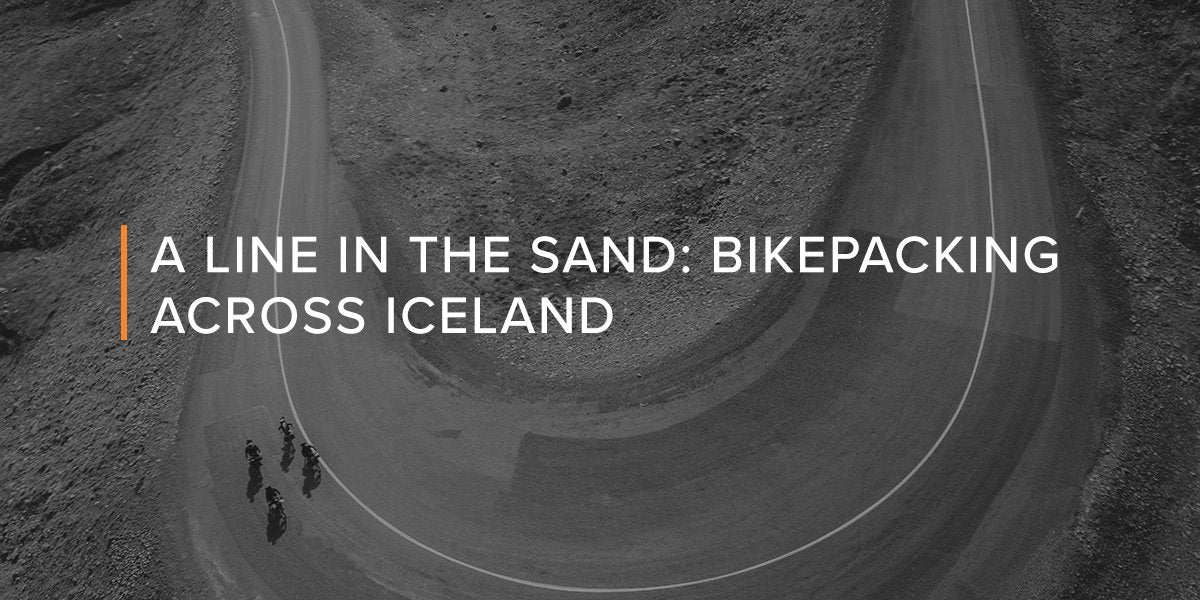A Line in the Sand: biking Iceland with Groove photographer Jordan Rosen
4 athletes. 800 miles. 1 insane goal - to bike across the rugged heart of Iceland.
What was once considered impossible became history on this epic adventure.
Two months ago, Groove Life still photographer Jordan Rosen headed across the world, armed with three cameras, to capture this wild adventure.
Joining RedBull, Sony | Alpha, and lululemon as a proud sponsor of this trip, Groove Life is thrilled to announce that, as of November 12th, YOU can experience this journey across Iceland through the short film A Line in the Sand.
About the Iceland trip
Photographer and athlete Chris Burkard, Canadian cross-country mountain biker and Olympic medalist Emily Batty, Emily’s brother Eric Batty, and her husband and coach Adam Morka set off on a bike-packing trek across Iceland. Their route started at the furthest east point of the country, crossed the rugged center of Iceland, and finished at the westernmost point. According to Jordan Rosen, the four athletes crossed hundreds of rivers and braved quicksand, freezing water, lava flows, navigated rocky paths, and covered more than 800 excruciating miles.
“Chris has been to Iceland a lot,” Jordan says. “He had this idea of completing what is really a first-ever crossing of Iceland through the center. Like many islands, what you’ve got is really big mountainous terrain in the center and inhabitable zones on the coast. No one lives in the center… There are no living communities in the center of that island. Full stop. It’s volcanic, the largest glaciers in Europe are all there, there’s quicksand, and there is pretty much no life. NASA, for two different Apollo missions, trained their astronauts to walk on the moon at this location - on the north side of the largest glacier, Vatnajökull. And it’s not a stretch.

Chris saw an opportunity to solve a major logistical challenge and do something that no one has done. He put the bikes together - they got these eighty to one hundred pound bicycles and they were able to ride across Iceland without our help.”
What was this trip like for the athletes and film and photography crew? We think Jordan says it best. “One piece of this journey that was special was getting to feel like we were really pushing the limits. There was indication from the Icelanders we had on our team or whom we were coordinating with that this route would ‘go’ for the cyclists, or for us as a production team. There was no guarantee that we’d be able to find and follow them the whole time, nor that we’d be able to cross rivers. Hundreds of rivers,” Jordan says. “The cyclists carried huge loads on their bikes - we had little confidence they’d be able to ford crossing after crossing. The prospect of hitting an impassable river or having a storm drop a bunch of snow was always there - and needing to double back or hunker was a real possibility.
Jordan went on to share that the center of Iceland is very unique. “‘The Big Empty,’ is what some Icelandic folks were calling this area of the country,” he says. “As with many islands, the towns exist largely on the coast. The interior is unpopulated, and in this case beautifully barren.”
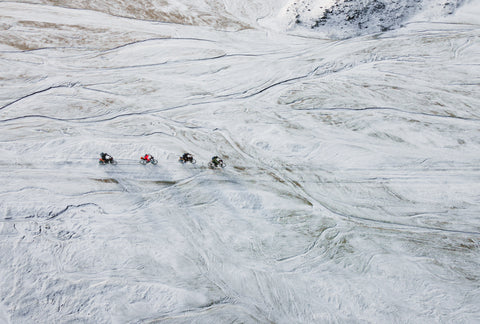
While Jordan and a film team chased the four bikers, they didn’t provide support to the athletes in any way. “This trip was unsupported, meaning they didn’t use an outside source that wasn’t accessible to the general public,” Jordan says. “What that means is they were able to stop at gas stations and they stopped at existing mountain huts. They didn’t create an opportunity [for assistance] and they didn’t have a vehicle to aid them like us, (the film and photo crew). At no point did we give them water when they ran out of water.”
“They would stay in huts and we would camp because a lot of times these huts are for emergencies,” Jordan says. “They’re very small and very old so there really wasn’t enough room for everyone to be in there, especially because we have so much (film) equipment.”
One of the mountain huts the athletes stayed in has a unique backstory. “One of the huts that we stayed in - as we affectionately called it The Star Wars Hut, just because it looked like it was on another planet - that hut was created when a plane crashed on Vatnajökull - the big glacier,” Jordan says. “They rescued the people off the glacier, and a group of Icelanders on the rescue team worked to get the plane off of the glacier. There were crevices and all these dangers and dragging the inoperable plane off of the glacier is pretty gnarly. They actually built a semi-permanent residence and two or three huts so they could go on and off the glacier. They built this hut right on the edge of the glacier. The glacier has since receded a little bit but it’s still right on the edge to the point that there is quicksand right near the hut. It’s really kinda scary. The rescue team dragged the plane off the glacier with a tractor after many weeks, put it in this valley where this hut is, and repaired it to the point that they flew it out of the valley. The hut that Chris, Emily and the group stayed in is THAT hut with that history where the mechanics recovered.”
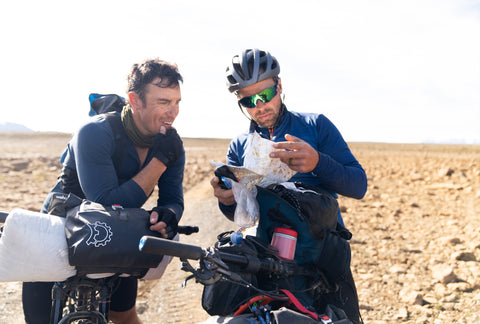
Expedition photography for this trip was intense
Groove Life photographer Jordan Rosen, who we interviewed in this blog post a few weeks ago, and the film crew had their own crazy adventure following the athletes. “It was like a constant leapfrog,” he says. “The cyclists never stopped for us to take photos - this was not a photo-op. It was two straight weeks of riding their bikes and us trying to keep up. There were a few days that it was just really tough terrain and we had to take different routes because the truck was really huge.”
Jordan has been a photographer for years and he credits a lot of his inspiration to Chris Burkhard. This trip was a dream come true for him. “For me, getting to go on this trip with Chris was a huge deal,” Jordan says. “Getting to be the photographer for the guy I’ve hero-worshipped a little… and for him to be like ‘yeah, you’re the guy who is going to take the photos on this trip,’ that’s really important to me. That was a big deal.”
Instead of bikes, the photo and film team had a highly modified off-road vehicle, but their journey had its own challenges. Jordan shared with our team what it means to be an expedition photographer on a crazy expedition like this. “In this trip that meant camping every single night, often in a big field of sand/volcanic ash that is blowing around in the arctic winds and getting in every little USB port that I didn’t know I had,” Jordan says. “We were running a generator into either our truck or tent or a bunch of different places - we charged like 25 cameras. I had three cameras just doing stills, the guys doing film must have had 15-20 cameras including action cams, the stabilizing equipment, and then four different drones, two of which crashed violently.”
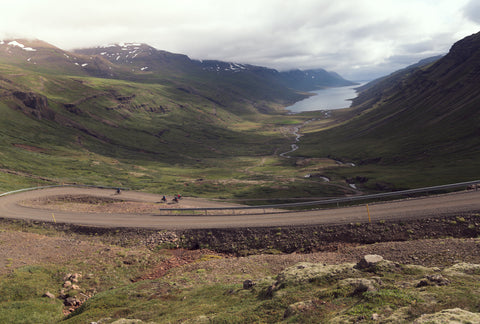
The whole team enjoyed the simplicity and resilience of Icelandic culture. While in conversation with Jordan on the trip, Elli Thor Magnussun shared an impactful story that represented the harsh and beautiful reality of life in Iceland. Jordan shared that story with us. “Iceland became a first-world country only recently,” he says. “There is a group of older people in Iceland who still remember seeing a plane fly for the first time, first having cars that work… it was really around the mid-40s that they got this type of equipment and weren’t using horses to move things. Elli was telling me that many years ago as a teenager he was talking to one of the old fishermen who would go out in the summer and freeze and salt the fish and in the winter repel off of these cliffs with fishing ropes and try and steal the bird eggs because there really isn’t anything else to eat. There aren’t forests in Iceland. There’s no wood to burn. They had to get very creative. He asked this old man, what is the thing or technology that changed his life the most. What has been the most incredible evolution. And this guy lived through everything - he lived through WWII, nuclear reactors, cars, planes, the internet - this old man told Elli that the thing that had changed his life the most was the Wellington rain boot. Because before rubber boots, his feet were permanently wet. He never, ever, ever had dry feet. And when Iceland got the Wellington rain boot, it changed his life forever because he never had wet feet again. I just don’t know where else in the world you can hear that story without talking to someone who is long gone.”
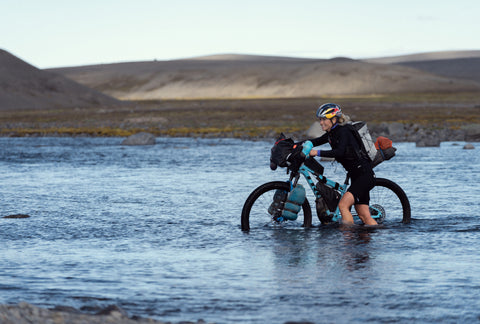
This trip across the center of Iceland didn’t shy away from the wild side of the country, which made it especially impactful. The athletes crossed these icy rivers, they stayed in small huts and navigated with the natural elements instead of battling them. They showed their appreciation for the authentic, intense beauty of Iceland by becoming one with it on their journey, and it was rewarding in every way.
While you may not be able to go and experience this for yourself, you can step into this wild world and get a glimpse of how it might feel to ride across lava rock and gravel for days on end, or watch the sunset over the ocean after accomplishing this adventurous goal. This film was created to share the beauty of Iceland with you, and we hope you enjoy the experience.
Where to watch the documentary A Line in the Sand
A Line in the Sand is a short film by Elli Thor Magnussun, The Empire, and Dadi Jonsson, released on November 12th. You can view it here or watch it above.
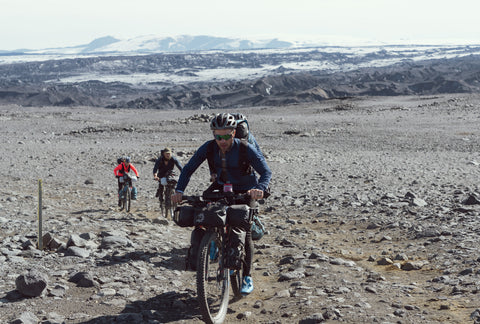
About Groove Life
Groove Life was created by adventurers for adventurers. We spend our days designing groundbreaking gear and getting it into your hands. We started out by designing the Groove Ring and now have created breathable silicone watch bands and The Groove Belt: the comfiest belt in history. But we’re not just passionate about adventure! If you’d like to learn a little more about what makes us different, check out our mission here.
Keep Groovin’!
